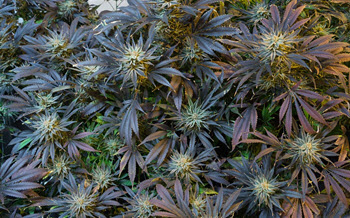Cannabis sativa is an annual herbaceous plant native to eastern Asia. It has been cultivated for thousands of years and virtually all parts of the plants have been used for various purposes, from rope manufacturing to medicine.
C. sativa is believed to have originated in a mountainous region northwest of the Himalayas.
Scientific classification
| Kingdom: | Plantae |
| Clade: | Angiosperms |
| Clade: | Eudicots |
| Clade: | Rosids |
| Order: | Rosales |
| Family: | Cannabaceae |
| Genus: | Cannabis |
| Species: | Cannabis sativa |
Subspecies
C. sativa ssp. sativa
C. sativa ssp. indica
C. sativa ssp. ruderalis
The plant
General info
- The tallness of the plant varies depending on variety and growing conditions, with some varieties being capable of growing as tall as 4 meters.
- Female plants tend to be shorter and more robust than male plants.
The leaves
- The lower leaf pairs normally sit opposite to each other, while the upper leaf pairs follow an alternate arrangement in mature plants.
- The first pair of leaves on a new plant tend to have just one leaflet. Eventually, the number of leaflets per leaf will increase. Seven, eight or nine leaflets per leaf is normal, but up to more than a dozen leaflets is not unheard of. Both variety and environmental conditions will impact the number. At the top of the plant, you can expect to see leaves with just one leaflet per leaf.
The flowers
- C. sativa is typically a dioecious plant, which means that each individual plant is either male or female. Some individual plants are naturally monoecious instead, which means that they have both male and female parts. Monoecious C. sativa plants are rare, and can be either sterile or fertile.
- Genetic and environmental factors decide if a plant will become male or female. One example of an environmental factor capable of altering the sexual expression is the diurnal light cycle.
- It is a short-day flowering plant, naturally inclined to produce flowers as the season changes from summer to fall and the days become shorter. Most individuals will require at least 12 hours of darkness per 24 hour cycle to flower.
- The flowering cycle will typically last between nine and fifteen weeks, depending on strain and environmental factors.
- The flowers of the female plant is arranged in racemes.
- The male plant will shed its pollen and die fairly soon thereafter. The female plant will live several weeks longer, since the seeds need time to ripen.
Since female plants are desired by many growers, commercial seed suppliers have begun offering seeds guaranteed to yield female plants. These seeds typically come from plants that have been treated with hormones or silver thiosulfate, or from plants that lack the male gene.
Uses
The Cannabis sativa plant is used for many different purposes, and have been throughout recorded history. Here are a few examples:
- From the seeds, hempseed oil can be extracted. This seed is traditionally used for cooking, for oil lamps and to make paints and lacquers.
- The seeds are common in seed-mixes sold as bird-feed.
- The fibers are used to make rope, cloth and similar products. The word canvas is derived from the name Cannabis.
- The flowers contain more psychoactive cannabinoid compounds than the rest of the plant, and are therefore the preferred choice when C. sativa is used for medicinal, spiritual or recreational purposes. It should be noted however that leaves, stems and seeds contain cannabinoids as well, just in lower concentrations. Resinous extracts are used to make hashish.
- In traditional Hindi medicine, C. sativa has been used as an analgesic, sedative and anti-inflammatory agent.
Different cultivars
 Most C. sativa plants cultivated today fall into one of three cultivar categories.
Most C. sativa plants cultivated today fall into one of three cultivar categories.
Category 1: Cultivars especially suitable for utilizing the fibers. These plants tend to have long stems and little branching.
Category 2: Cultivars especially suitable for seed production.
Category 3: Cultivars especially suitable for medicinal, spiritual or recreational use. They have a high content of cannabinoids.
Pharmacology
- The C. sativa plant contains over a hundred different identified cannabinoids. Most of them are only produced in trace amounts.
- The main psychoactive cannabinoid of C. sativa is tetrahydrocannabinol (THC).
- Cannabidiol (CBD) is a cannabinoid produced in high concentrations in some C. sativa plants. Not only is this cannabinoid not psychoactive, but it has actually been shown to block the effect of TCH in the nervous system.Synthetic THC (dronabinol) contains no CBD, and this might be one of the reasons why usage of synthetic THC can have such a different pharmacological effect on the human body compared to using parts of the plant.
- In addition to the cannabinoids, the C. sativa plant contains many different volatile terpenes and sesquiterpenes that gives it its characteristic aroma.
Examples of chemical compounds found in the C. sativa plant:
- α-Humulene
- α-Pinene
- α-Terpinolene
- Caryophyllene
- Limonene
- Linalool
- Myrcene
- Trans-β-ocimene
- Trans-caryophyllene
